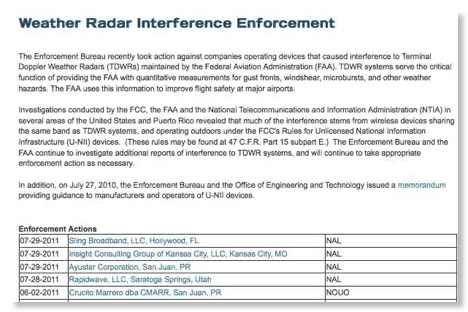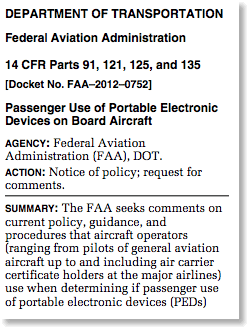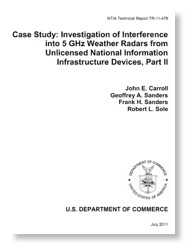FAA's Spectrum Management Activities May Be Getting "Adult Supervision"
If you’re sitting on a plane at the gate and reading this column on an electronic gadget, you’re about to hear eight dreaded words: “Please power down your electronic devices for takeoff.” But this time next year, you might hear something very different: “Please put your devices on ‘airplane mode’ for takeoff.”

In a phone interview, Ms. McCaskill said she had grown frustrated with the F.A.A.’s stance on devices after she learned that the agency now allows iPads as flight manuals in the cockpit and has subsequently given out devices to some flight attendants with information on flight procedures.
“So it’s O.K. to have iPads in the cockpit; it’s O.K. for flight attendants — and they are not in a panic — yet it’s not O.K. for the traveling public,” she said. “A flying copy of ‘War and Peace’ is more dangerous than a Kindle.”

Now maybe if NTIA were more aggressive with FAA in asking it to justify their spectrum management decisions this mess might never have happened. Perhaps if the recommendations of Chapter 5 of the PCAST spectrum report were implemented there would be more accountability by all federal agencies for their spectrum management decisions.
Thanks, Mr. Akin!
NY Times: "The F.A.A. has no proof that electronic devices can harm a plane’s avionics, but it still perpetuates such claims" "Dealing with the F.A.A. on this topic is like arguing with a stubborn teenager"
Readers may recall that SpectrumTalk has repeatedly talked about the FAA’s renegade role in spectrum management: apparently not happy that Congress has split spectrum management between FCC and NTIA (with some international issues at State), FAA likes to impose itself as another coequal player in national spectrum management. Meanwhile NTIA for decades, glowing in its power derived from Section 305 of the Communications Act, has lacked the moral backbone and institutional authority to keep FAA in line with respect to national spectrum policy issues.
Recently the NY Times published the article whose heading is shown above. Here is a quote:
Dealing with the F.A.A. on this topic is like arguing with a stubborn teenager. The agency has no proof that electronic devices can harm a plane’s avionics, but it still perpetuates such claims, spreading irrational fear among millions of fliers.
A year ago, when I first asked Les Dorr, a spokesman for the F.A.A., why the rule existed, he said the agency was being cautious because there was no proof that device use was completely safe. He also said it was because passengers needed to pay attention during takeoff.
When I asked why I can read a printed book but not a digital one, the agency changed its reasoning. I was told by another F.A.A. representative that it was because an iPad or Kindle could put out enough electromagnetic emissions to disrupt the flight. Yet a few weeks later, the F.A.A. proudly announced that pilots could now use iPads in the cockpit instead of paper flight manuals.
Now FAA likes to say that the problem is “aggregation” - the impact of many emitters operating at the same time. But the real problem of aggregation comes from faulty technical analysis of the spectrum problems.
While aggregation can happen in some scenarios, e.g. terrestrial transmitters operating cochannel with a satellite uplink, real multipath propagation - as happens in most scenarios int he real world - results in lognormal propagation path losses in one or two emitters dominating the interference scenario and the others having no impact.
The Times points out that In December both FCC Chairman Genachowski and Senator Claire McCaskill (D-MO) both urged FAA to be more rational with respect to use of devices on aircraft. Sen. McCaskill even wrote that she was “prepared to pursue legislative solutions should progress be made too slowly.” She said she was urging the agency to embrace the use of electronics, including laptop computers, e-readers, smartphones and other devices, “during the full duration of a flight.”
“The current rules are inconvenient to travelers, don’t make sense and lack a scientific basis,” she said in the letter. “Airline employees have the incredibly important job of keeping us safe in the air. Their efforts are better spent worrying about rules that actually accomplish that goal.”
FAA likes to say that it is only obsessed with safety - an admirable goal if true. However, the sordid history of the FM/ILS affair also shows that FAA is just as concerned about the proprietary interests of “its constituency” - the airlines and AOPA - than it is of safety issues. Also the FAA’s bizarre 2006 NPRM, never coordinated with either FCC or NTIA, that proposed giving the agency veto power over both federal and nonfederal spectrum use in dozens of bands shows a fundamental misunderstanding of the public interest in spectrum.
So kudos to NY Times for their great coverage of this issue. When will NTIA and Congress pressure FAA to start acting more rationally on spectrum matters?
Silicon Flatirons Spectrum Conference Papers Available
Also Paper on FM/ILS Controversy
In U.S. Spectrum Policy: The Way Forward, Kathryn C. Brown and Charla Rath
Beyond Kolkata: Delivering on the Fundamental Goals of the Communications Act, Michele C. Farquhar
Not A Zero Sum Game - Why Objections To The PCAST Report Make No Sense, Harold Feld
The Stunted Public Interest Vocabulary in the Broadcast Spectrum Auction, Ellen P. Goodman
U.S. Spectrum Policy - When the Rubber Meets the Road, Kathleen Ham and Sara Leibman
The Promise and Problems of Strategic Plans, Charles L. Jackson
The Promise and Problems of Strategic Plans: From the Spectrum Policy Task Force to the PCAST Report, Michael J. Marcus
The View Ahead: Technology Opportunities, Preston Marshall
The Wireless Data Demand: Technology and Spectrum Implications, Edward G. Tiedemann, Jr.

However, there are lessons to be learned from this long simmering dispute: Receiver standards often have economic externalities - those who pay the cost are not the same as those who get the benefits. If we do not recognize this issue and find a way to deal with them there will be no progression this area.
Instrument Landing System Receiver Standards:
A Case Study of Receiver Regulation and Its Difficulties
The Instrument Landing System (ILS), used worldwide by aviation users, has two bands, one of which is just above the FM broadcast band at 108.1 -112 MHz. This safety-related landing system has been standardized by both FAA and ICAO, the ITU’s aviation counterpart. Unfortunately the adjacency to the FM broadcast band results in a possible vulnerability to receiver-generated intermodulation interference. This vulnerability was confirmed in FCC Lab measurements.(1 2) FAA and FCC have had a long standing disagreement on the best public policy approach to prevent such interference and NTIA has generally taken a neutral role with respect to this issue and has not been directly involved.
ICAO adopted immunity standards for ILS receivers that were effective international in 1998. (Those stands are mentioned by NTIA on p. 29 of its receiver standards compilation; The specifics of the ICAO regulation can be found in this document from the South African FAA counterpart.) FAA has implemented the ICAO regulation but still allows use of the previous generation of receivers and uses its powers under the Airways Facilities Act to threaten new or modified FM broadcast facilities for “hazard determinations” if they apply for a location, frequency, or power that would cause interference to the earlier generation receivers as projected by a FAA computer model that was not adopted in a “notice and comment” proceeding.
FCC proposed in 1993 to require only ICAO-complaint receivers in all US aircraft after the 1998 effectiveness date. (the NPRM was in response to this petition from broadcast interests.) This NPRM was opposed by aviation interests that felt they should not be burdened with replacing receivers in order to facilitate the use of broadcast spectrum (1 2 3). FCC took no further action on this NPRM until the docket was closed in a 2002 housekeeping action for being “stale”.
It is generally felt that airliners and corporate jets are not affected by this issue since, for practical purposes, they must be equipped to fly outside the US and therefore have ICAO-complaint receivers. However, there are small general aviation aircraft that are not actually required to be ILS-equipped that may well have the previous generation receivers and their trade association, AOPA, has vociferously objected to a mandated upgrade. (It is thought that all ILS receivers made anywhere in the past 20 years comply with the ICAO standard so that any noncompliant receiver in present use is likely 20+ years old.)
This receiver standard issue is a classic economic externality. The aviation users who would incur the cost of a new receiver would get no direct benefit. The benefits would accrue to broadcasters who could modify their facilities to better serve the public though power or siting changes and to the public that would receive addition FM stations if present FAA objections to some new allotments were dropped.
As in the GPS/LightSquared issue, this also falls squarely on the FCC/NTIA jurisdictional fault line, although complicated by the role of FAA and its partially overlapping jurisdiction.
Developing receiver standards is a technically complex issue. But in this case there is a specific international standard that was developed with participation of all affected parties. The US ambivalence towards receiver standards has left that standard in limbo in the US in the 2 decades since it was developed and has limited the utilization of FM broadcast spectrum in order to avoid putting any increased regulatory burdens on an ever decreasing number of small aircraft with obsolescent receivers that could not be used in most other countries.
It is not clear how this issue can ever be resolved due to the jurisdictional issues unless the Executive Branch takes a more holistic approach to such spectrum issues.
FAA and Passenger Electronics Use
Will the familiar warning for airline passengers to "discontinue the use of all portable electronic devices" become a relic of the past?
Perhaps.
By popular demand, the Federal Aviation Administration is forming a group to study policies governing the use of consumer electronics in the sky.
The review could lead to increased use of iPads, portable DVD players and other consumer electronics in aircraft cabins.
Note that the issue here is electronics other than cell phones. Use of cell phones in aircraft is banned by FCC because at high altitudes a cell phone will “see” and impact many cell sites. Thus it will use a large amount of cellular capacity.
FCC did consider allowing femtocell-like base stations in aircraft in Docket 04-435 , but rejected the idea after a tsunami of consumer opposition about the social impact of having someone in the next seat talking loudly (since cell phones have little or no sidetone to given user feedback on appropriate speech level).
Older readers will recall that until about 20 years ago FAA forbid all cell phone use on aircraft, even when the plane was stopped on the runway. FAA wraps itself in its “safety culture” and in pandering to its constituency, e.g. ATA (now actually A4A) and AOPA - but not the general public - to be as unaccountable as possible in some decisions. (Amusingly, FAA staffers routinely criticize FCC for being too close to its constituency.)
The oral traditional about the change about 20 years ago was that a key member of Congress with oversight authority over FAA was trapped on a plane at DCA’s runway for 2 hours without being able to use his cell phone. When he got back to his office he summoned the FAA Administrator and demanded a justification for the then existing rule on no cell phone use ever in aircraft. When the FAA Administrator finally demanded from his middle managers an explanation, he saw he “had no cards” and the present policy of limited cell phone use on the runway was quickly adopted.
As a service to SpectrumTalk readers, here is a link to the actual FAA “ Notice of policy; request for comments” on Passenger Use of Portable Electronic Devices on Board Aircraft .
DATES: Written comments must be received on or before October 30, 2012
Note that this document states “The FCC will be a key partner in this activity working collaboratively with the FAA, airlines, and the manufacturers to explore broader use of PEDS in flight.” I would like to believe this is true, but as someone with 2 awards from the FAA Administrator for helping FAA resolve critical safety problems, this statement does not ring true. Also, the inability of the FAA spokesman at the FCC Receiver workshop in March to even mentioned the longstanding FM/ILS disagreement between the 2 agencies shows that bilateral collegiality has a long way to go between these agencies. NTIA continues to turn a blind eye to such issues.
U-NII/Weather Radar Interference Update

The FCC/EB webpage linked to the picture above now lists 17 FCC enforcement actions related to U-NII interference to FAA TDWR weather radars since 2007. For those not familiar with the jargon here, a March post here reported how 5 GHz unlicensed U-NII equipment operating in the 5.47-5.725 GHz band are required to have dynamic frequency selection (DFS) as defined by 15.407(h), basically a listen-before-talk (LBT) cognitive radio system, in order to avoid interference to several types of federal government radar systems that operate in the same band. The Terminal Doppler Weather Radar, an FAA weather radar near airports, has been receiving interference in several cases despite this requirement. The big question - Why?
NTIA/ITS recently released the second of a 3 part report series that deals with the issue as shown at left. This report has the following interesting quote:
(One)U-NII device was tested against FCC DFS certification waveforms and it did not detect any. It also failed to detect any emulated TDWR waveforms. The device, however, was FCC certified, meaning it had passed these same tests when the FCC laboratory tested its DFS performance. A firmware update from the manufacturer eventually rectified this problem, illustrating how firmware upgrades can lead to DFS non-compliance.
This strongly implies that the manufacturer changed the firmware after FCC approval. While the original FCC software defined radio (SDR) rules would have made such a software change a Class 3 Permissive Change and required regulatory review, the softening of the rules in Docket 03-108 and deletion of the former 2.932(e) gave a green light to such software changes.
Two March 2010 enforcement actions seem to confirm this. These involved Airspan and Motorola. Airspan agreed in a consent decree as follows:
Remedial Measures. Airspan has developed and distributed to its United States MicroMAX customers a software upgrade for its MicroMAXdevice that prevents users from disabling the DFS radar detection mechanism and varying any other operating parameters of the device.
Thus they were selling a unit where the users could turn off the required DFS capability needed to protect safety-related FAA radars! Airspan agreed to make a $10,000 “voluntary payment” to the Treasury as part of the consent decree.
Motorola agreed to a $9,000 “voluntary payment” but their consent decree is more cryptic than the one for Airspan or a similar one for Axxcelera Broadband Wireless, Inc. that appears to be based on a hardware component issue not a software change. The Airspan consent decree has clearly stated “remedial measures” that says what they will correct, Moto gets off with a $1,000 small “voluntary payment” (trivial to what this must have cost in legal fees), a vague agreement to train their employees better:
Motorola will train and provide materials concerning Section 302(b) of the Act and Parts 2 and 15 of the Rules pertaining to U-NII devices and the requirements of the Consent Decree to those of its employees who are involved directly in the development and marketing of U-NII devices imported, marketed and sold by Motorola in the United States.
Cryptically the consent decree states
On April 20, 2009, the Bureau issued an LOI (letter of inquiry) to Motorola. The LOI directed Motorola to submit a sworn written response to a series of questions relating to the marketing and selling of U-NII devices. Motorola responded to the LOI on May 20, 2009.
The content of Moto’s response to the LOI indicating how this happened is not on the public record. This is reminiscent of the “professional courtesy” Moto used to get from FCC when it was the dominant player in the mobile radio field and contrasts with how the lesser firms, Airspan and Axxcelera, were treated - they both paid a greater “voluntary payment” and had their violation more explicitly reported. Moto’s failings are not given in the public document, only in the referenced in the publicly unavailable 5/20/09 LOI response.
The coddling and preferential treatment of Motorola was common in the past but neglects the fact that it may have contributed to Moto’s lack of competitiveness and its ultimate demise as the top mobile radio firm. In the past Moto may have stressed its regulatory prowess over its technical prowess and was not prepared for the level playing field that cellular presented with new competitors. As Trefis reported
Motorola’s market share is expected to decline from a high of 22% in 2006 to 2.8% in 2010, [3] and could continue to decline to 1.6% by the end of Trefis forecast period(2011).
UPDATE
You blogger has filed a FOIA request for the above mentioned Motorola response to the FCC letter of inquiry (LOI) and will publish here the text when received. Today, the following interim response from FCC was received:
Your Freedom of Information Act ("FOIA") request dated August 11, 2011, was assigned to the Commission's Enforcement Bureau. You seek the response to a Letter of Inquiry ("LOI") issued in the Enforcement Bureau's investigation of Motorola, Inc. ("Motorola") (EB-09-SE-064). Motorola responded to the LOI on May 20, 2009. This email is to inform you that Motorola filed a request for confidential treatment of most of its LOI response pursuant to 47 C.F.R. § 0.459 of the Commission's rules. Since the confidentiality request is pending, pursuant to Section 0.461(d)(3) of the Commission's rules, we will serve Motorola with a copy of your FOIA request and afford them 10 calendar days to respond. Motorola also is required to serve you with a copy of its response.
The criteria for withholding such information is given in 47 CFR 0.457(d) . We patiently await word from Motorola if it is willing to let the world know why its equipment violated FCC rules or whether they will fight the release of any substantive information.






![Validate my RSS feed [Valid RSS]](valid-rss-rogers.png)

